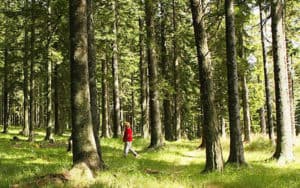
You can find out the rationale for this proposed CE in a (very nicely explained IMHO) document here. Kudos to the EMC staff! I also liked their benchmarking with other agencies’ CE’s- not sure that that’s been done before.
Here’s the text:
36 CFR 220.5(e)(26). Ecosystem restoration and/or resilience activities on NFS lands in compliance with the applicable land management plan, including, but not limited to the plan’s goals, objectives, or desired conditions. Activities to improve ecosystem health, resilience, and other watershed conditions cannot exceed 7,300 treated acres. If commercial/non-commercial timber harvest activities are proposed they must be carried out in combination with at least one additional restoration activity and harvested acres cannot exceed 4,200 of the 7,300 acres.
(1) Restoration and resilience activities include, but are not limited to:(i) Terrestrial and aquatic habitat improvement and/or creation,
(ii) Stream restoration, aquatic organism passage, or erosion control,
(iii) Road and/or trail decommissioning (system and non-system),
(iv) Control of invasive species and reestablishing native species.
(v) Hazardous fuels reduction and/or wildfire risk reduction,
(vi) Prescribed burning,
(vii) Reforestation,
(viii) Commercial harvest, and/or
(ix) Non/pre-commercial thinning.(2) Road and trail limitation. A restoration/resilience activity under this category may include:
(i) Construction of permanent roads up to 0.5 miles.
(ii) Maintenance or reconstruction of NFS roads and system trails, such as relocation of road or trail segments to address resource impacts.
(iii) Construction of temporary roads up to 2.5 miles. All temporary roads constructed for a project under this category shall be decommissioned no later than 3 years after the date the project is completed.Definition of Restoration
The Forest Service defines restoration in its Ecosystem Restoration Policy (FSH 1909.12 and 36 CFR 219.19) as “the process of assisting the recovery of an ecosystem that has been degraded, damaged, or destroyed. Ecological restoration focuses on reestablishing the composition, structure, pattern, and ecological processes necessary to facilitate terrestrial and aquatic ecosystems sustainability, resilience, and health under current and future conditions. Functional restoration focuses on the underlying processes that may be degraded, regardless of the structural condition of the ecosystem.”
It seems to me that the activities have to meet the legal bar of “activities to improve ecosystem health, resilience, and other watershed conditions”. I don’t really understand what viii means.. as I think the environmental impact is from the removal of trees, and not whether it’s commercial or not.
Here’s what the analysis Matthew posted here says about this:
Broadly defined “ecosystem restoration and/or resilience activities” on up to 7,300 acres, including commercial logging of up to 4,200 acres, as long as it includes at least one restoration add-on (e.g., replacing a culvert to restore fish passage). The CE could be used to authorize up to 6.6 square miles of logging with no public input or environmental analysis.
I actually disagree with the “no environmental analysis”. The deciding official generally lays out the approach to a project from the ID team. You can find your own examples of categorical exclusion decision memos, I collected them for a while. Here’s an example. But I’m talking what the FS actually does and perhaps the folks who wrote this analysis are thinking “the worst that possibly could be done.” But they still have to document why the CE is appropriate in the DM.. so?
Would people like it better if the maximum were say 1000 acres of thinning (no regeneration harvests of living trees?). I think it’s partially a “not trusting that the FS won’t do something really bad with this flexibility”. How could that be reduced? Another collaborative requirement (similar to the legislative CE’s)?
You are right that the only real requirement that remains is that they not be arbitrary or capricious in finding that a category applies and there are no extraordinary circumstances, which seems like it would require some amount of analysis. However, I don’t think you should assume that the Forest Service will continue to do what it “actually does” when the point of these new CEs is to do things differently (faster, and possibly “really bad”).
The definition of “restoration” is taken from the 2012 Planning Rule. In that context, it serves the purpose of helping develop desired conditions and objectives for the forest plan. In this context, of implementing a forest plan, it sounds like it could be an independent determination (especially because “health” and “resilience” are not otherwise defined), which would be wrong. It should instead refer to that definition, but make it clear that for a project to constitute “restoration” it must be reestablishing the composition, structure, pattern, and ecological processes defined by forest plan components.
That might be a problem with pre 2000 plans. And of course, it would make more sense to call it “resilience to changing future conditions” rather than “restoration to the past” but that would require another Planning Rule, I guess. ;).. Wait a minute, here’s what they say in the draft reg preamble 27549 left column.
Interesting that the target is sustainability resilience and health, but the approach is reestablishing the past to do so.
Well, that’s actually in the Planning Rule (36 CFR 219.19). But you have a good point. The common understanding of the term “restoration” is to make something like it was. That can be inconsistent with the requirement in plans for sustainability, so they have tried to change the meaning with this internally inconsistent redefinition. In fact I’ve argued that the concept of “restoration” shouldn’t be used in planning at all; plans should just specify the desired condition for ecological integrity.
While the definition is flawed, the actual language in the Planning Rule does make sense.
“The plan must include plan components, including standards or guidelines, to maintain or
restore the ecological integrity of terrestrial and aquatic ecosystems and watersheds in the plan area…” (36 CFR 219.8(a)).
Restoring ecological integrity (as an umbrella concept) does not necessarily mean restoring any pre-existing condition.